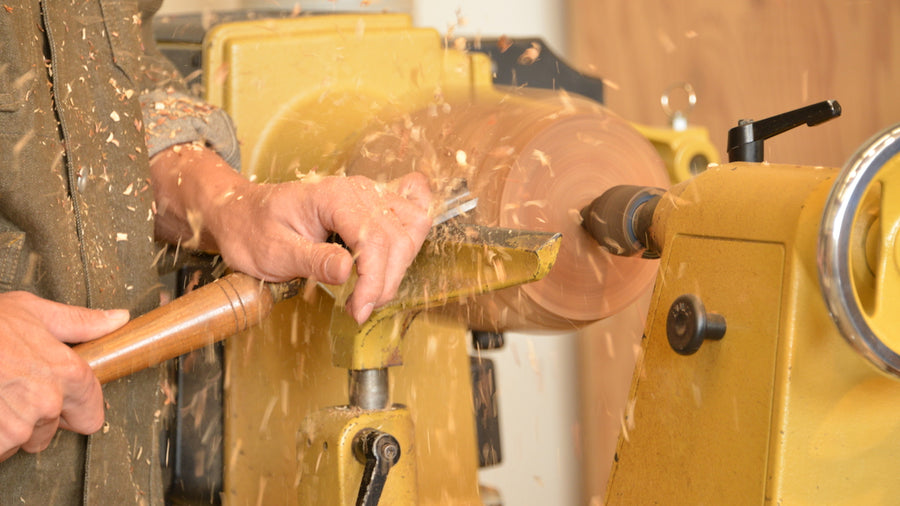商品化を考えるにあたり、日本の道具とうつわを取り扱うお店「空櫁」の五井あすかさんを訪ねた際に尋ねられました。普段の暮らしの中に灯をともす時間を持つための道具は、神域で育った春日大社境内の杉の魅力を感じてもらう商品としてぴったりです。こうして燭台づくりが始まりました。
木材から同軸上にものを切り出すには、旋盤(ロクロ、ターニング)という技術が役立ちます。
五井さんからご紹介いただいたのは Nakajima woodturning studioの中島信太郎さん。ウッドターニング専門の教室や機械販売に加え、作家としての創作活動をし、ウッドターニング・旋盤加工の面白さと専門知識・技術の普及に尽力されています。
加工は、どの木材を使うか決める「木取り」から始まります。木目や反り、腐食具合などを見極めて、燭台に適したものを選ぶことが最初の作業です。
“Do you use a candleholder?”
This was the question that Asuka Goi asked us when we visited her Japanese arts and crafts store, “Soramitsu” in Nara.
Candleholder- the tool to light the candle to have a relaxing moment sounds like a perfect fit for our special new product in order to make the most use of the old cedar wood that used to be grown in the sanctuary of the Kasuga Taisha (Kasuga Grand Shrine), which is registered as UNESCO World Heritage Site. In this way, candleholder making started.
In order to cut out the prototype of the candleholder coaxially from wood, a woodturning lathe and the technique seems to be useful. So we met Shintaro Nakajima, the artisan of the Nakajima Woodturning Studio with Goi’s introduction.
While Nakajima teaches the woodturning classes, sells the machines and has engaged in creative activities as an expert and an artist, he had been dedicating himself to conveying the fun of woodturning and lathe process, disseminating his extensive knowledge and expertise.
The first step of the wood processing starts with planning. Which wood/ wood part can we take to use? After carefully identifying wood grains, warpages, corrosion and condition of each wood, we carefully chose the ones that were suitable for the candleholders.

Nakajima woodturning studio
木取りされた木材は、制作しやすいように、25センチほどの長さの角材に加工されます。四角い木材に刃物があてがわれ、「カッカッカ」というダイナミックで小気味よい音が立ちます。角が取れるにしたがい刃を変えると、「シュルシュル」という音になり、燭台が削り出されていきます。
Then, the selected wooden part is processed into square lumber with a length of about 25 centimeters. After cutting each corner and surface with different types of cutting blade, the details of a candleholder shape have come out.

Good Job!メンバーによる手作業の表面仕上げ
削り出された燭台にはすべて、表面に加工を施しています。ここからは、Good Job!センター香芝で、障害のある人たちの手仕事によって仕上がります。
仕上げには「酢鉄染め」、「オイル仕上げ」の2種を選びました。Nakajima woodturning studioより竹田亜希子さんにお越しいただき、染めやオイル仕上げの方法をメンバーに実演のうえ指導していただきました。
酢に溶けた鉄分と、杉に含まれるタンニンとが反応し、酸化することによって、褐色や黒色に木肌が変化します。
Surface Finish by People with disabilities working at the Good Job! Center
All the carved candleholders have a surface finish. People with disabilities working at the Good Job! Center Kashiba in Nara take care of the hand-craft part.
There are two final finished types available, “vinegar-iron dye” and “oil finish” for all the candleholders. Akiko Takeda from the Nakajima woodturning Studio visited us to demonstrate how to dye and finish products with oil and gave a guidance to the Good Job! Center‘s members with disabilities.
The iron dissolved in vinegar reacts with the tannins contained in the cedar. They oxidize and cause the bark to turn into brown or black color.

真鍮のかすがい
削り出して、染めや表面仕上げを行う過程の中で、いくつかの燭台には割れが生じました。
この割れは、木材が呼吸している証で、その程度は木材によって千差万別。末長くお使いいただくために、両端が針になった金具「かすがい」が打ち込まれています。
このかすがいも、割れに合わせ、その台ごとに作って打ち込んでいます。
PRODUCT
“Kasugai” metal fitting made to fit each crack
There might be cracks on some candleholders since they are naturally made during the process of carving, dyeing and surface finishing.
The crack is a proof that the wood is breathing, and the degree of crack varies depending on the wood. In order to use it for a long time, metal fittings "Kasugai" with needles are driven in on both ends of each crack.
The metal fitting is also created and driven one by one, adjusting each clack for each candleholder.



企画・販売:Good Job!センター香芝
クリエイティブディレクション:五井あすか(空櫁)
設計・加工:Nakajima woodturning studio
木材認証管理:あたつく組合
春日大社への参拝風景 写真:衣笠名津美
燭台のイメージ写真 写真:上山敦司
燭台の商品写真 写真:伊藤誠一(Good Job!センター香芝)
全体管理:藤井克英(Good Job!センター香芝)
Planning&Sales promotion: Good Job! Center Kashiba
Creative direction: Asuka Goi (Saramitsu)
Design & manufacturing: Nakajima Woodturning Studio
Wood Certification management: Atatsuku kumiai
Photograph (Kasuga Taisha Shrine) : Natsumi Kinugusa
Photograph (Candleholder image) : Atsushi Kamiyama
Photograph (Candleholder product) : Seiichi Ito (Good Job! Center Kashiba)
Project management: Katsuhide Fuji (Good Job! Center Kashiba)









